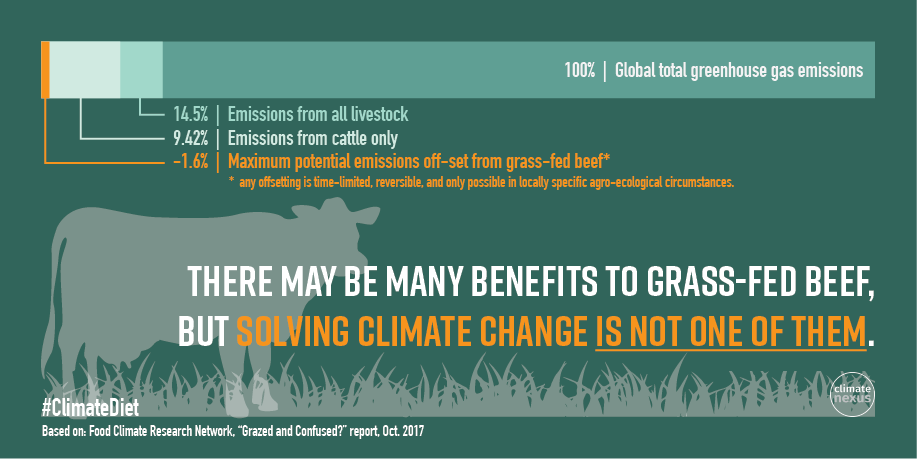How do cattle drive climate change?
Cattle are a type of mammal called ruminants, which are able to break down plants rich in cellulose by fermenting and digesting them in a multi-part specialized stomach. This “enteric fermentation” process allows them to obtain nutrients from grazing in fields and pastures. However, grass is more difficult to digest than grain, and so grazing livestock tend to produce more methane (the notorious “cow burps and farts” problem), a greenhouse gas with roughly 28 times the warming potential of CO2 over a 100-year time frame.
Cattle mainly eat grain once they are sent to feedlots, where most spend the last three to six months of their lives. Corn and other concentrates are easier to digest than grass, resulting in fewer emission from enteric fermentation. However, there are other greenhouse gas emissions associated with cattle feedlots, as well as concerns about as animal welfare, water pollution, and antibiotic resistance. Manure contains carbon and nitrogen, and when large amounts of manure are stored in large ponds, they break down without oxygen and produce methane. The amount of methane depends on how much manure is produced and how much decomposes anaerobically – both tend to be higher in feedlots where cattle live and feed in close quarters and manure is stored as liquid in ponds.
How much do cattle emissions contribute to climate change?
The UN Food and Agriculture Organization (FAO) estimates the livestock sector as a whole contributes 14.5 percent of total man-made greenhouse gas emissions – beef and milk production make up the majority of this. Most of those emissions (42 percent) come from enteric fermentation, with an additional 23 percent from manure application and management (from both methane and nitrous oxide).
Agriculture and livestock production represents a relatively smaller portion of emissions in the U.S., around nine percent nationwide. Enteric fermentation from ruminants represents almost a third of that and was also the largest single man-made source of methane emissions in the U.S. in 2015, comprising 25 percent of total methane emissions. While methane from natural gas and petroleum decreased from 1990 to 2015, methane emissions from enteric fermentation and manure have increased 1.5 and 78 percent respectively. In short, emissions from cattle, and livestock production generally, represent a significant and increasing problem.

Can cattle’s impact be offset by good grazing and management practices?
Some argue that grazing cattle offsets these burp- and manure-driven emissions by helping sequester more carbon in the soil. Grazing livestock nibble at grass, which encourages plant growth and deeper roots. If these plants, living or dead, are left undisturbed, the carbon in the plants’ biomass can stay stable in the ground rather than be re-emitted into the atmosphere. Cattle don’t need to consume crops like corn and grain (as chicken and pigs do), which are associated with climate change-driving deforestation, land use change, and nitrogen-based fertilizer use. When well-managed, grazing production systems allow livestock manure, containing carbon and nitrogen, to re-enter the soil, fostering increased plant growth and sequestering more carbon. Livestock manure can replace energy-intensive synthetic fertilizers, thus avoiding greenhouse gas emissions. Livestock also have an important place in food security, offering a source of income source of livelihoods and dietary diversity to many across the world.
There are many proclaimed benefits of grass-fed beef, which deserve their own research and exploration – animal welfare, more fertile soil, increased biodiversity, healthier and more nutritious meat, and reduced use of fertilizer and antibiotics, to name a few. However, limiting the discussion to cattle’s net greenhouse gas emissions, there are a few problems with relying on grass-fed beef as a climate solution.
Soil carbon storage is time-limited, reversible, and the potential depends on very specific conditions. Soils reach “carbon equilibrium” within a few decades, after which no more carbon can be drawn down from the atmosphere (without a corresponding loss of soil carbon). Carbon stored in soils can also be lost into the atmosphere as a result of poor grazing management, a change in land use (i.e. tilling for crops), or natural causes such as drought. The amount of carbon soil can hold also depends on a number of factors, including type of soil, the regional climate, how often the soil is disturbed, and the kind of vegetation and soil microbes present.
Furthermore, efforts to sequester carbon in soil can be at odds with management practices to limit nitrous oxide emissions – a greenhouse gas with 298 times the warming potential of CO2 over a 100-year time frame. Increasing nitrogen (from manure or other sources) promotes plant growth, which fosters carbon sequestration, but also potentially causes more emissions of nitrous oxide, undermining the climate benefit of carbon storage.
Grass-fed beef also supplies a very small portion of the protein we eat – just 1 gram of the 31 grams of protein from animal sources the average person is estimated to consume daily by 2050 – but livestock grazing takes up roughly 26 percent of the world’s terrestrial land, according to the FAO. Grassland is not a free and unlimited resource – it could be used for many other beneficial purposes – and even grassland can carry an environmental cost from fertilizer inputs or deforestation.
How much can grass-fed beef lower cattle’s climate change impact?
Not enough to offset cattle’s contribution to climate emissions, and certainly not enough to fix the larger climate crisis.
A 2017 report out of Oxford’s Food Climate Research Network estimates that with careful management practices and very specific agro-ecological circumstances, grass-fed cattle can offset between 20 and 60 percent of emissions from grazing systems, or four to eleven percent of total emissions from livestock production. While there is some potential for mitigation, there is no such thing as a “carbon-free lunch” when it comes to beef. Grass-fed beef is not a scalable climate solution – but lowering demand for meat and dairy overall can be.



